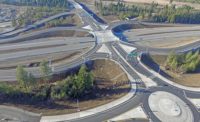Dixie Drive Interchange Promises Relief From Traffic Congestion
For decades, traffic congestion in the southern Utah city of St. George was limited to St. George Boulevard, which would swell with traffic during the spring and summer as tourists and retirees crowded into the area to enjoy its temperate climate and nearby national parks.

From 2000 to 2005, St. George was the fastest-growing metropolitan region in the U.S., according to census data, and traffic congestion was becoming a regular occurrence. During the height of the population boom in this city about 100 miles northeast of Las Vegas, traffic engineers began looking for a solution.
Today, the $58-million Dixie Drive Interchange is on track to provide a new single-point interchange on Interstate 15 and improve access to the city's walking/biking trails and convention center, and assist in flood mitigation along the Virgin and Santa Clara rivers, which converge in the area. St. George is known regionally as Utah's Dixie because cotton was grown there by the Mormon pioneers in the 1860s.
A Traffic Funnel
Lee Cabell, project manager for Horrocks Engineers, a civil engineering firm based in Pleasant Grove, Utah, says the Dixie Drive Interchange project began as a way to relieve congestion on the interchange at Bluff Street, less than a mile north of the current project site.
Because development in St. George is mostly dispersed over rugged desert and around black-rock mesas, traffic was funneled onto a limited number of streets that had access to I-15 or crossed from one side of town to the other. The problem was particularly acute on Bluff Street.
Dixie Drive, a second major thoroughfare south of Bluff Street, carried traffic from the growing suburbs of Santa Clara and Ivins and past the Dixie Convention Center, but it had no access to the freeway. Before the redesign, Dixie Drive meandered from west to east until it met I-15. It then ran north to join with Bluff Street, carrying heavy traffic to an already crowded intersection.
Cabell says that even though Dixie Drive is relatively close to the Bluff Street intersection, it still made sense for a new freeway interchange.
“It just seemed like the whole world was coming at that intersection at Bluff Street and there was no way to fix it so it could handle the expected 70,000-80,000 cars predicted for the future,” Cabell says. “We decided to create this other interchange on Dixie Drive. Now we'll have two interchanges that can handle 45,000 to 50,000 [vehicles] each and a longer useful life than just redesigning Bluff Street.”
Multiple Components


